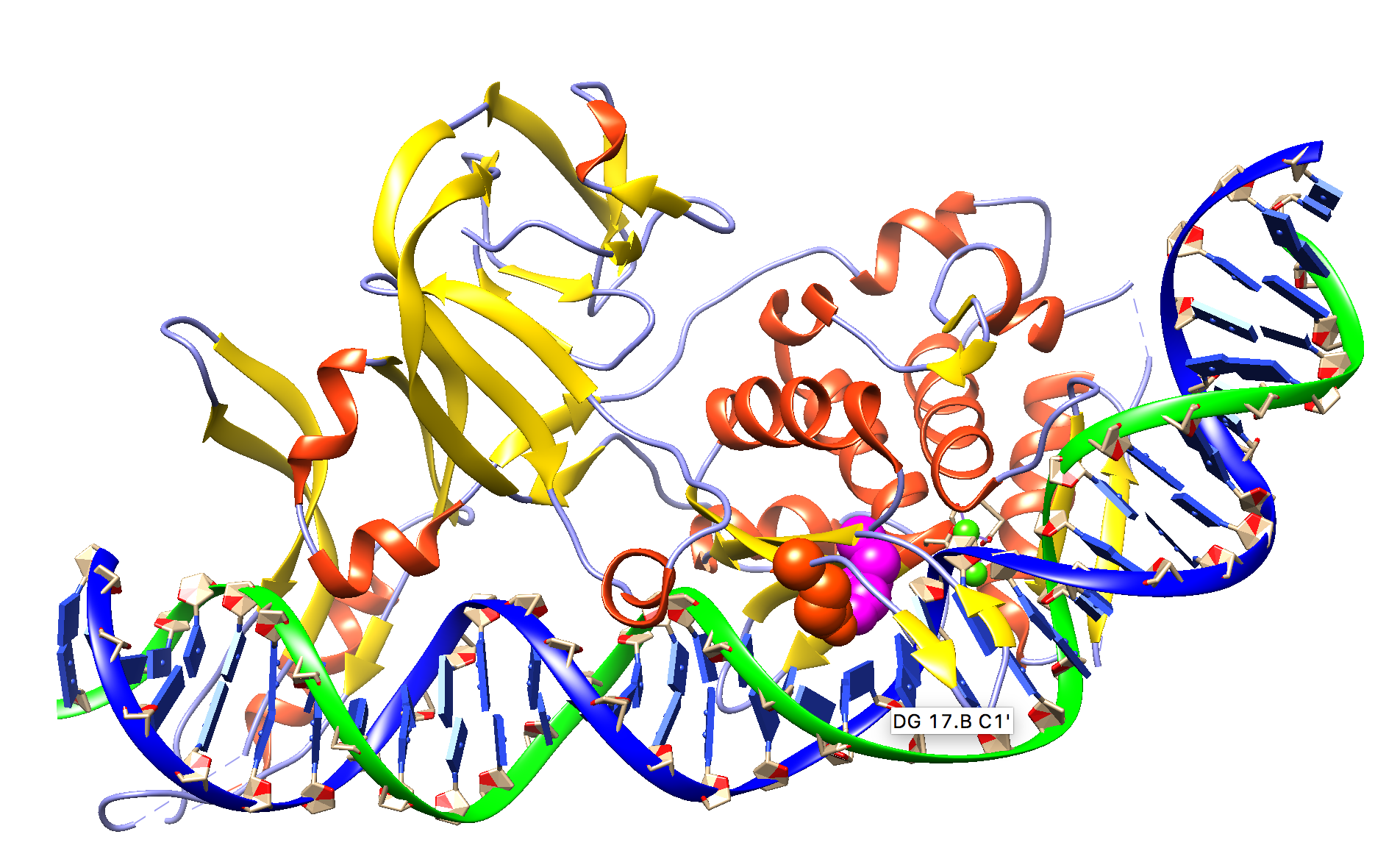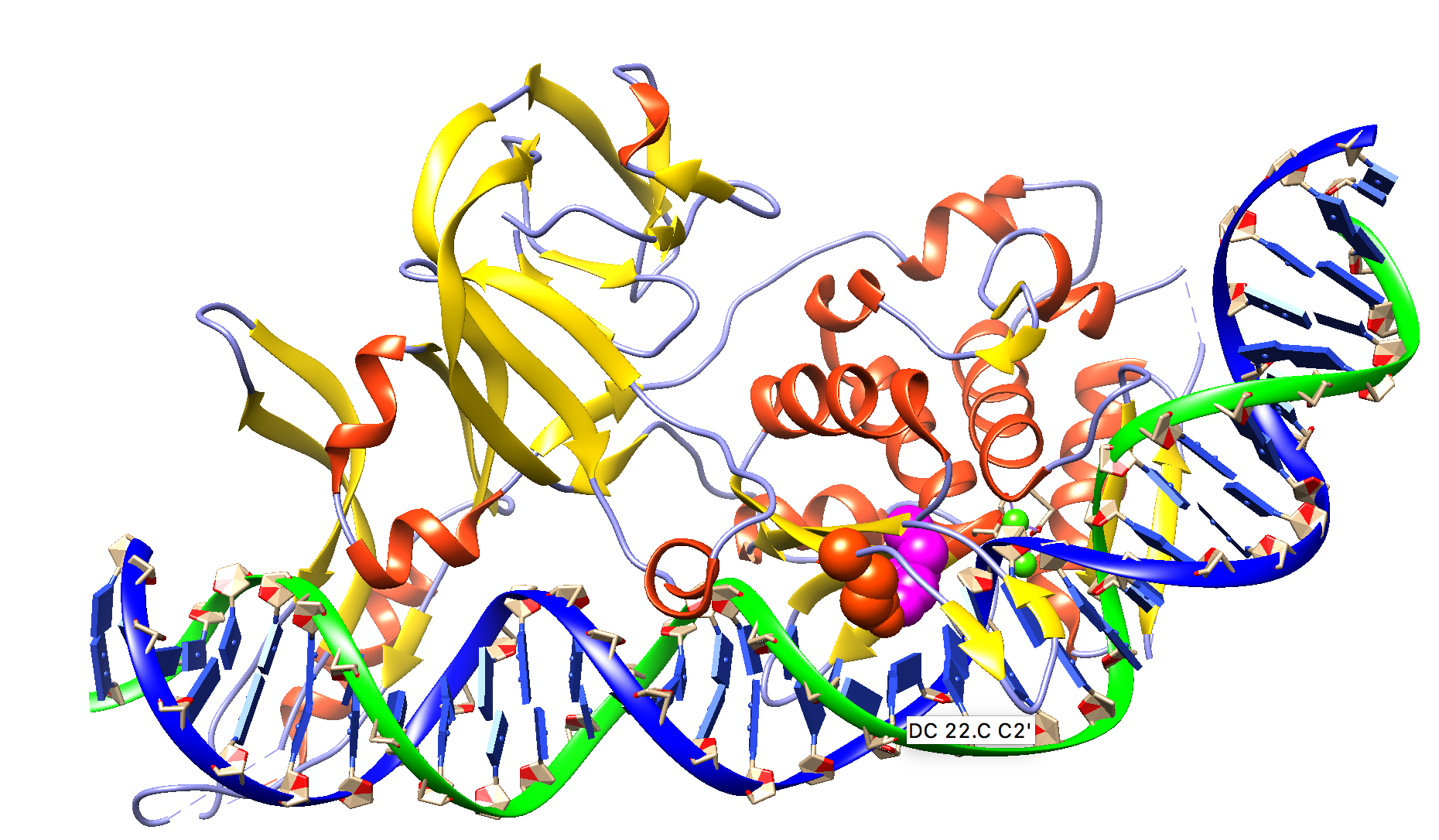Assignment for Today
- How does the relationship between observed sequence divergence (p) and substitution events (d) change, when the different bases (or aa) do not occur with the same frequency?
Discussion
Interactions between aa and DNA: THe question in that lab asks for base pairs, i.e. part of the DNA
Lys 340: magenta, Glu366: red


Gaia versus Medea (see class05)
Feedback loops in GAIA - subsystems can evolve by natural selection
Bottomline on Gaia?
Definitions of life?
See posted answers on class home page!
Which of the following statements is correct:
- All complex sequences that show significant similarity in a pairwise sequence comparison are homologous
- All homologous sequences show significant similarity in a pairwise sequence comparison.
- Both of the above statements are correct
Which of the following is NOT considered strong evidence for homology?
- The arrangement of secondary structure elements in space is the same or very similar.
- Significant primary sequence similarity
- Significant primary sequence identity
- Identical function
- None of the above
Selection for function can preserve sequence similarity in the pairwise comparison of homologous proteins, across domains separated by how many years of independent evolution?
- Thousands
- Millions
- Billions
- Limited only by how long life has existed
- All of the above
Which of the following is NOT part of the explanation for how complex functional molecules were assembled, despite the vastness of protein space?
- Gaia directs protein evolution, through negative feedback loops, to the correct region of protein space.
- There are multiple unrelated solutions for the same functionality, exemplified by the fact that there are non-homologous enzymes inhabiting completely different regions of protein space with the same function.
- An exact function does not need to be hit upon, because natural selection can take a protein with limited function and make it better.
- Similar structures have similar function, so there are entire regions of protein space occupied by homologs that all function equally well, or nearly so.
- Protein space is made slightly smaller by removing all of the possibilities that cannot be synthesized or they will clog up the ribosome
Assignments for Wednesday
- Watch video on reconstructing the Tree of Life
- What does the term phylogeny mean?
- TREE of LIFE overview here, (optional: compare here, here, here and here (especially the discussion is interesting).
- Read through Olga's Time-line of the Universe here
- Read through box below on "How old is life on Earth?"
Assignments for Friday
- Read through file on frequently used formats here
- Explore the Genbank Sample file here
Natural Selection and Evolution
When does "evolution" occur? An
algorithmic approach.
"Darwin's Dangerous Idea" by Daniel C.
Dennett, Chapter on Evolution as algorithm is a reading assignment for
Monday, Sept. 13. [available through WebCT]
What is needed for evolution to occur?
(Note, this is different from stating that this is all that occurs in evolution)
- Offspring similar but not identical to parents
- More offspring than necessary
- Competition for resources, mates => survival of the
fittest.
What processes in biological evolution go beyond inheritance
with variation and selection? (We'll discuss many of the following
later in the semester.) Alternatives to evolution by natural selection?
- Horizontal gene transfer and recombination
- Polyploidization (angiosperm and vertebrate evolution) see here and here
- Fusion and cooperation of organisms (Kefir, lichen, also
the eukaryotic cell)
- Evolution of the holobiont (host + symbionts)
- Targeted mutations (?), genetic memory (?) (see Foster's and Hall's reviews on directed/adaptive mutations; see here for a counterpoint)
- Random genetic drift
- Gratuitous
complexity
- Selfish genes (who/what is the subject of evolution?)
- Parasitism, altruism, gene transfer agents
- Mutationism, hopeful monsters
|
Slides on Mutual Aid versus(?) Natural Selection here
How old is life on Earth?
- The Earth is about 4.6 Ga old, but no crustal rocks
has survived from that time. The oldest rocks are no older than 4.0
Ga. But zircon crystals dated to 4.4 billion years BP are found in rocks, are considered evidence for Earth's crust having had formed and being in contact with water already 4.4 billion years BP (here and here)
Morphological Fossil Evidence:
- For about a decade the oldest microfossils were considered
to be about 3.5 Ga old (see here). The fossils (as interpreted by Bill Schopf) look like
"modern" Cyanobacteria. Compare the time to to molecular trees of life:
Is this a problem? However, the evidence for these fossils was
questioned.
- 3.2Ga old filamentous fossils, probably of
thermophilic chemotrophic prokaryotes (Rasmussen,
2000)
- 1.8Ga old fossils from Gunflint formation:
iron-loving bacteria and cyanobacteria
Biological Signature Evidence (examples):
- Oldest geological evidence for life - 3.8 Ga ago -
is based on 13C discrimination (carbon derived from living
systems often have lower delta 13C values than inorganic
carbonates) [here].
The rocks are from Akilia island off the coast of Greenland, and
severely altered by metamorphism. However, recently the evidence for
that was reassessed.
- 3.7 billion year of rocks from the Isua formation in Greenland contain structures described as stromatholites. here in NYT, report in Nature
- The amount of carbon in the Issua formation (and its discrimination against agains 13C) is interpreted by Minik Rosing to indicate a highly productive biosphere. (See Minik's presentation at the 2011 ISSOL meeting. Especially slides 6 ff are interesting - the handwritten slides were written with the sedimentary rocks - containing lots of graphite.)
- 2.7Ga old: probable biomarkers of cyanobacteria and
of eukaryotes (Roger Summons, Roger Buick and Jochen Brocks)
See Olga's Timeline of the Universe here
|
If time, go through slides on high temperature origin of life and the late heavy bombardment



